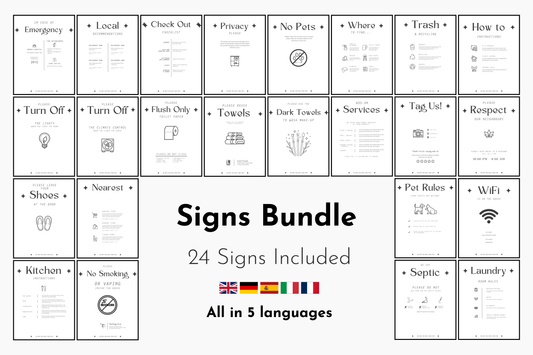As travel trends evolve, many Airbnb hosts are recognizing the growing demand for long-term stays. Whether it’s digital nomads, remote workers, students, or families in transition, more guests are seeking accommodations that offer the comfort of home for an extended period. Optimizing your Airbnb for long-term stays not only ensures higher occupancy rates but also creates stable, consistent income. Here’s how to tailor your listing, amenities, and approach to attract and satisfy long-term guests.
Why Optimize for Long-Term Stays?
-
Stable Income: Longer bookings mean you can secure consistent earnings without the turnover of short-term stays. You’ll spend less time managing check-ins and cleaning, which can reduce your overall workload.
-
Reduced Vacancy Rates: By focusing on long-term guests, you can keep your property occupied for longer periods, minimizing the downtime between bookings and maximizing your rental's potential.
-
Appealing to Growing Demand: As more people work remotely and seek flexible living options, the demand for month-long or multi-month stays has increased. Optimizing your Airbnb for these types of guests ensures you stay competitive and relevant in this market.
-
Lower Maintenance Costs: With fewer turnovers, you’ll spend less on cleaning, laundry, and utilities for each guest. Additionally, longer-term guests are more likely to treat the property like their own home, which can lead to less wear and tear compared to frequent short-term guests.
Steps to Optimize Your Airbnb for Long-Term Stays
1. Offer Competitive Long-Term Discounts
Pricing is a major factor for guests booking extended stays. To attract these renters, you should offer competitive weekly or monthly discounts. Many travelers seek long-term rentals specifically to save money compared to daily rates, so offering a significant discount for longer stays can make your listing more attractive.
-
Weekly and Monthly Rates: Airbnb allows you to set custom weekly and monthly discounts directly in your listing settings. A standard discount might range from 10-15% for weekly stays and up to 30% for monthly bookings, depending on your market.
-
Adjust for Seasonality: During slow seasons, offering steeper discounts can help you fill vacancies. On the other hand, during peak seasons, your long-term discount might be lower as demand is higher.
2. Highlight Long-Term Stay Amenities
Long-term guests typically look for more amenities than short-term visitors, as they want to feel comfortable in the space for an extended period. Tailoring your amenities to meet their needs will make your property more attractive for longer stays:
-
Fully Equipped Kitchen: Long-term guests often prefer to cook at home, so ensure your kitchen is stocked with everything they might need—pots, pans, utensils, a microwave, and enough dinnerware for multiple meals.
-
Ample Storage Space: Extended stays mean guests will bring more belongings, so providing plenty of storage is key. Offer ample closet space, dressers, and storage bins to make it easy for them to settle in.
-
Laundry Facilities: A washer and dryer—either in-unit or easily accessible—are essential for long-term stays. If your listing doesn’t have in-unit laundry, consider partnering with a local laundry service to provide discounted options for guests.
-
Workspace or Desk Area: With the rise of remote work, many long-term guests will be working from your Airbnb. Ensure you provide a comfortable desk area, high-speed Wi-Fi, and plenty of outlets to accommodate their needs.
-
Comfortable Living Spaces: Invest in quality furniture and ensure there is enough seating for lounging. Since long-term guests spend more time at the property, the comfort of the living room and bedroom is critical.
-
Outdoor Space: If available, make your outdoor areas cozy and inviting. A small patio, balcony, or garden space where guests can relax adds appeal, especially for those staying long-term.
3. Adapt Your Listing Description for Long-Term Guests
When updating your Airbnb listing, be sure to speak directly to the needs of long-term guests in your description. Highlight the features that make your space suitable for extended stays:
-
Focus on Comfort and Convenience: Mention the full kitchen, laundry facilities, and workspace. Emphasize that your property is designed to feel like a home away from home for long-term guests.
-
Detail Nearby Amenities: Long-term guests will want to know what’s in the surrounding area. Mention nearby grocery stores, parks, public transportation, gyms, and other conveniences that make daily living easier for extended stays.
-
Promote Privacy and Quiet: Long-term guests, especially remote workers, will appreciate knowing that your space is peaceful and conducive to productivity. If your property is located in a quiet neighborhood or offers privacy, be sure to mention this in your description.
4. Update Your House Rules for Long-Term Guests
The expectations for long-term stays differ from short-term visits, so be sure to update your house rules to reflect this. Here are some key considerations:
-
Utility Use: Make it clear whether utilities like electricity, water, and internet are included in the rental price, or if there are usage caps. This is especially important for very long-term stays where higher utility usage could affect your bottom line.
-
Housekeeping and Cleaning: Decide how often you expect cleaning to occur during long stays. Many hosts offer a cleaning service every two weeks or once a month to maintain the property’s condition. Specify who is responsible for ongoing cleaning and if you will provide cleaning supplies.
-
Guests and Visitors: For long-term stays, you might want to adjust your policy on guests and visitors. Consider whether long-term tenants can have overnight guests or additional people staying for extended periods, and outline these terms clearly.
-
Pet Policy: If you allow pets, long-term guests may be more likely to bring them along. Make sure your pet policy is clear, including any additional fees or rules about the number or type of pets allowed.
5. Improve Communication and Flexibility
Long-term guests often have different needs than short-term ones, so being open, communicative, and flexible is crucial to a positive experience:
-
Be Responsive: Ensure that you or your property manager is available to answer any questions or address concerns promptly. Long-term guests may require more assistance initially as they settle into the space.
-
Flexible Check-in and Check-out: Long-term stays often involve more complex schedules. Be flexible with check-in and check-out times, especially if guests are moving from another city or need extra time to vacate.
-
Maintenance and Repairs: For long-term stays, regular maintenance may be required. Be proactive about fixing issues like plumbing or appliances and have a system in place for guests to report problems.
6. Simplify the Booking Process
Streamline the booking process to attract long-term guests who want a hassle-free experience:
-
Instant Book Option: Allowing Instant Book can attract long-term guests who want to secure accommodation without waiting for host approval. Just make sure your house rules and pricing are clear upfront to avoid misunderstandings.
-
Clear Cancellation Policy: While you may want to protect your earnings with a firm cancellation policy, long-term guests prefer flexibility, especially if they’re relocating for work or personal reasons. Consider offering a moderate cancellation policy for extended stays.
7. Furnish Thoughtful Extras
Long-term guests appreciate thoughtful touches that make their stay more convenient:
-
Stock the Kitchen with Essentials: Provide basic kitchen items such as spices, cooking oil, and coffee to help guests feel at home right away.
-
Provide Cleaning Supplies: Long-term guests will need to maintain the space themselves, so provide vacuum cleaners, brooms, mops, and other cleaning essentials to keep the property in good condition.
-
Local Guide and Welcome Information: Create a digital or physical guide that provides details about the local area, from the best restaurants and grocery stores to public transportation options and local services like dry cleaning or gyms.
Conclusion
Optimizing your Airbnb for long-term stays is a smart strategy for securing steady income and reducing vacancy rates. By offering competitive pricing, highlighting amenities that appeal to long-term guests, and being flexible with house rules and policies, you can position your property to attract a new wave of travelers. With a focus on comfort, convenience, and clear communication, you can ensure that long-term guests not only enjoy their stay but also feel at home—leading to positive reviews, repeat bookings, and potentially even referrals from satisfied guests.























